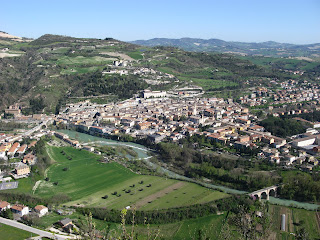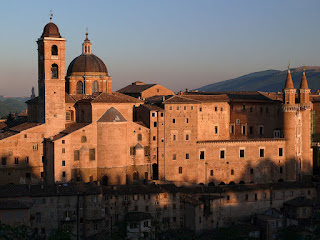Forward-thinking designer who helped shape modern Urbino
 |
| De Carlo's ideas often put him at odds with more traditional urban planners |
De Carlo was also a writer and educator, who was critical of what he saw as the failure of 20th century architecture. Many of his building projects were in Urbino, the city in Marche known for its 15th century ducal palace and as the birthplace of the painter Raphael.
He put forward a master plan for Urbino between 1958-64, which involved new buildings and renovations added carefully to the existing fabric of the city, described as genteel modernism and designed with the lives of Urbino citizens in mind.
The most notable parts of the Urbino project were at the University of Urbino, where he worked for decades, constructing housing, classroom and administration buildings, carefully embedded into the hilly landscape and designed to facilitate ease of movement between parts of the campus.
He also built Matteotti New Village, a social housing project in Terni in Umbria to provide homes for the employees of Italy’s largest steel company, designed housing for working people in Matera in Basilicata and worked on the Mirano Hospital in Venice, buildings for the University of Siena, and the redevelopment of the Piazza della Mostra, Trento.
De Carlo’s buildings reflected his views on the involvement of users and inhabitants in the design process. On the Terni housing project, for example, he insisted that workers be paid to attend consultation sessions to enable him to understand better how they wanted to live.
.jpg) |
| The Palazzo Battiferri at the University of Urbino, part of De Carlo's biggest planning project |
De Carlo was educated at Milan Polytechnic, where he graduated in engineering in 1943. He joined the Italian navy but with Italy’s surrender to the Allies in September of that year he went into hiding, then joined the Italian Resistance movement. Together with another architect, Giuseppe Pagano, he organized an anarchist-libertarian partisan group in Milan, the Matteotti Brigades.
He resumed his studies in 1948, obtaining an architecture degree from the University of Venice before opening his first studio in Milan. His progressive views came to the fore when he produced a series of short films denouncing prevalent ideas about the modern metropolis and, as a professor of urban planning, often clashed with other architects, who he claimed put abstract ideas ahead of the interests of people and their environment.
His 1956 housing project in Matera ignored most of what had become the accepted principles of modern architecture in favour of design sympathetic to the geographical, social and climatic context of the region. Architects who shared his progressive views joined together in the group known as Team 10.
De Carlo began working on his Urbino project in 1964, winning international recognition for his designs for the University Campus. During the 1968 student uprisings, he sought constructive dialogue with the students and subsequently wrote a number of essays in which he explored his theories on what became known as “participatory architecture”, underpinned by his own libertarian socialist ideals
Among many honours, De Carlo was awarded the Wolf Prize in Arts in 1988 and the RIBA Royal Gold Medal in 1993. He died in Milan in 2005.
 |
| As well as being the home of Raphael, Urbino offers the attraction of a beautiful ducal palace |
Urbino, which is 36km (22 miles) inland from the Adriatic resort of Pesaro, in the Marche region, is a majestic city on a steep hill. It was once a famous centre of learning and culture, known not just in Italy but also in its glory days throughout Europe, attracting outstanding artists and scholars to enjoy the patronage of the noble rulers. The Ducal Palace - a Renaissance building made famous by Baldassare Castiglione’s Book of the Courtier - is now one of the most important monuments in Italy and is listed as a Unesco World Heritage site. Inside the palace, the National Gallery of the Marche features paintings by Titian and Raphael, who was born in Urbino, and there are more examples of Raphael’s paintings at his house - Casa Natale di Raffaello - in Via Raffaello. The University swells the city’s population by up to 20,000. Urbino is home to a number of gastronomic delights, including crescia sfogliata, a flatbread often served stuffed with melted caciotta cheese, and prosciutto di Carpegna, a local cured ham.
 |
| Matera is renowned for its famous cave district, the Sassi di Matera, to which visitors flock |
Declared a European Capital of Culture in 2019, the city of Matera in Basilicata, where De Carlo completed his first important housing project, is famous for an area called the Sassi di Matera, made up of former cave-dwellings carved into an ancient river canyon. The area became associated with extreme poverty in the last century and was evacuated in 1952, lying abandoned until the 1980s, when a gradual process of regeneration began. Now, the area contains restaurants, hotels and museums and is an increasingly popular destination for visitors. The oldest part of the city, known as the Civita, sits above the cave districts on a flat, rocky plateau. Before they were turned into new dwellings, the caves became an extension to the Civita, used for storage and stabling horses. The Cattedrale della Madonna della Bruna e di Sant'Eustachio, Matera’s duomo, built in Apulian Romanesque style in the 13th century, can be found at Civita’s highest point.
Also on this day:
1572: The death of Loredana Marcello, Dogaressa of Venice
1685: The birth of composer Lodovico Giustini
1889: The death in Venice of the English poet, Robert Browning
1901: Guglielmo Marconi receives the first transatlantic radio signal
1957: The birth of novelist Susanna Tamaro
1969: The Piazza Fontana bombing in Milan




































